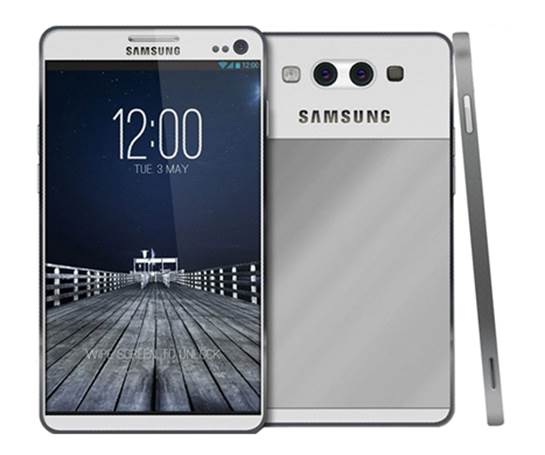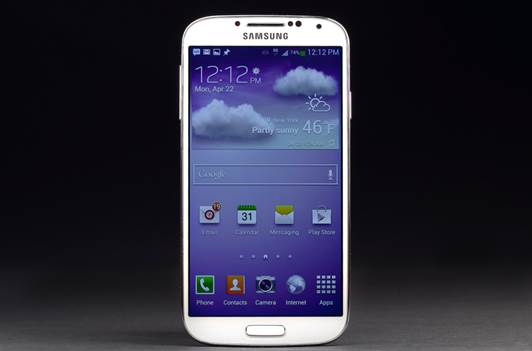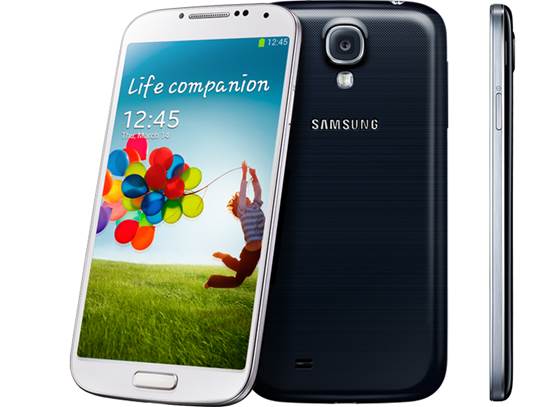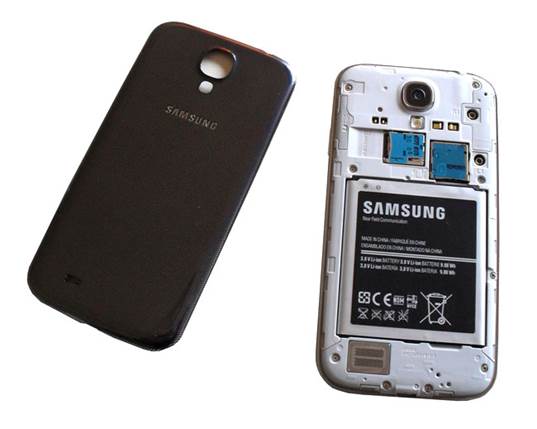Samsung Galaxy S4 is the newest and coolest
phone from Korea. This was a hero, the chosen device to lead the attack of Samsung
when it dug deeper in 2013, and it was equipped with the best: 1,080p Super
AMOLED screen, quad-core 1.9GHz processor (or 1.6GHz Exynos 5 Octa 5410, depends
on the market), Android 4.2, 13MP camera and many new firmware utilities etc.
Hardware
If your first crush on Galaxy S4 was the
same to ours, we thought that you could hardly discriminate it from the last
year’s flagship model. However, take a closer look it’s obvious that the design
group of Samsung actually didn’t use the past year to make up for its lost
sleep they spent when designing GS3. The phone maker kept the same general
design, but it made some important changes to improve the appearance.

Galaxy
S4
The choice of building material of Samsung is
none of them. If you’re the one who criticize the plastic structure of GS3, you’ll
be disappointed with its predecessor – the company kept its age-old traditions
which was keeping metal away from the assembly lines by constructing the frame,
back case and the fake chrome edges with polycarbonate. It’s the same – despite
belonging to lower-class and not being made with machines – with the plastic
type you will have on the high-end phones such as Nokia Lumia 920 or even HTC
One X+, so there’s nothing unusual for Samsung. The biggest benefit of using
this kind of material is that it provides more elasticity when you drop the
phone, it’s still pretty solid, and feels as if it were as durable as GS3 or
Galaxy Note II. This may be ideal for the potential for many potential buyers,
but we still prefer the high-class build quality and the exterior
attractiveness of HTC One, thanks to using high-end aluminum throughout the
entire monolithic device frame.

If
your first crush on Galaxy S4 was the same to ours, we thought that you could
hardly discriminate it from the last year’s flagship model.
One of the most sophisticated changes for
the design of GS4 could be one of the most efficient changes: Gorilla Glass 3 sits
right under the screen edge. This small move makes the screen less damaged than
GS3, which has the glass sitting above the edge a little. This won’t secure the
safety of the screen when you drop the phone, but at least it increases the
survival chance of the phone after an impact on the edge.
Another change is the selection of the
ornaments of Samsung. At release, GS4 will be provided with Frost White (white)
and Black Mist (black) colors, both of which has cross pattern lasting from the
front to the back. This design is pretty sophisticated in our tested white
model and adds a little of personality to one device which on the other hand is
simple and glossy. However, it stands out more on the black model, to the
extent of causing eyesore. When comparing to the dark version, we prefer the
metal kind of look on the green GS3. (To be true, we have spent more time with
the white model, so our point of view toward the black version is based on the
first impression we have before the review).

At
release, GS4 will be provided with Frost White (white) and Black Mist (black)
colors, both of which has cross pattern lasting from the front to the back.
Considering the technical specs, it has
larger screen than the 4.8inch predecessor, but 5inch GS4 is actually narrower (69.8mm
wide, comparing with 70.6mm on GS3), so it only adds a little vertical screen
space and has thinner bezels on each side. GS4 loses most of sophisticated curves
present on the last-generation phone, as it’s designed with larger corner and
full-faced back, both of which are the sign to show that Samsung has stayed
away from the “naturally inspired” spell. Fortunately, this means that finally
we have begun to say goodbye to the quartz-like design and feeling: the edges
are straighter from H to T, giving our fingers much surface for grasping, and
the back cover sits flat on the fake chrome edges instead of curving around it
like the waves of the sea. The entire surface is still plain and glossy;
however, it’s easier to wrap your hands around this device. 7.9mm thick (0.31
inch), Galaxy S 4 is 0.7mm thinner (0.027 inch) than its elder brother. It’s
also 3g lighter (0.11 ounce). In brief, the differences between 2 devices can’t
be easy to recognize unless you take a close look at both side by side.
While the home button is almost even with
the rest of the body on GS3, the buttons of S4 is elevated pretty much. On one
side, the physical buttons are much easier to press by this way; on the other
hand, it floats on the remains of the screen to the extent that our fingers
wipe against it when swiping downwards the screen. That’s a respect of the
phone that we can get familiar to, though it’s a pity that its position ruins
the design line. With the rest of the front, the menu and back keys sit on the
flank of the home button on the left and right, which is completely vice versa
to the layout used on lots of OEM Android devices. Along the screen top, you
will find a 2.1MP front camera, earpiece grille and lots of sensors.

Considering
the technical specs, it has larger screen than the 4.8inch predecessor, but
5inch GS4 is actually narrower (69.8mm wide, comparing with 70.6mm on GS3), so
it only adds a little vertical screen space and has thinner bezels on each
side.
Turn the phone upside down, you’re
presented with a little emerged camera module on the top with the LED flash
right below, and 2 slots on the mono speaker sit near the bottom; the plastic
layer between them is raised to stop the sound from being muffled when the
phone face upwards. The compulsory logos are also present here: “Galaxy S4”, sitting
right under the traditional-style set of speakers, and the carrier logo (T-Mobile
in this case) sits under the flash.
Samsung loves to make the back cover
removable, which means that you can easily access the 2,600mAh battery (also
hold the role as an NFC antenna), along with microSDXC and micro-SIM slots – as
well as the contacts for touch charging – right above it. We hope to hear more
from the wireless charging options of the phone from Samsung, but all we know
at this point is that the company intends to sell the optional back cover with
this feature preinstalled. (considering the concern toward Qi of Verizon, we
won’t surprise if its GS4 version releases with this option).

Samsung
loves to make the back cover removable, which means that you can easily access
the 2,600mAh battery
Around the fake chrome edges, you will find
a volume rocker on the left, power button on the right, micro-USB/MHL 2.0 under
the 3.5mm headphone jack, mic and the infrared transceiver on the top. It’s
interesting to see infrared once again be popular, because at this time we’re
seeing it in some of the premium devices, though at this point it’s used in a
completely different way comparing to the time of Palm Treo and other IrDA devices.
Which is to say, the main reason for the tech to be used before was the focus
on the data transfer and “beaming”, but today it’s only provided as a joint
remote.